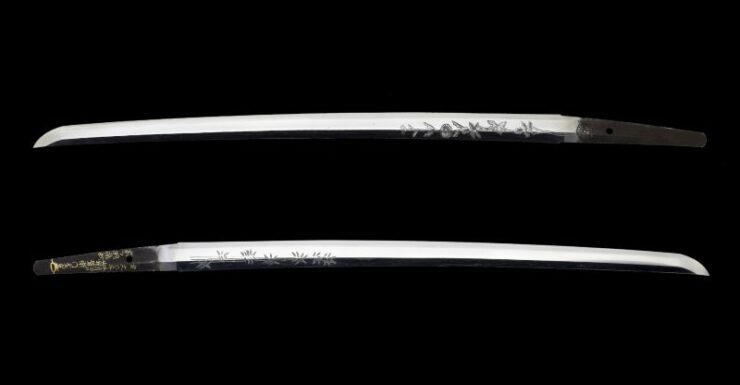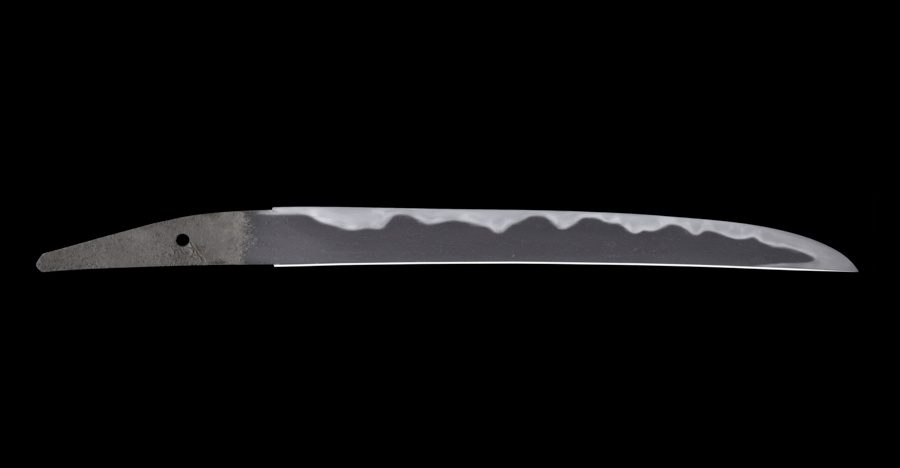Explaining Boshi: Defining Characteristics and Diverse Types

The boshi is the continuation of the hamon, the pattern of the hardened edge, at the tip of the blade. Generally, the quality of the boshi reflects the skill of the swordsmith and the overall quality of the blade. It varies greatly and can help determine the blade’s swordsmith and swordmaking tradition or school.
KEY TAKEAWAYS:
- The boshi is a critical part in Japanese swords, reflecting the swordsmith’s skill and indicating the blade’s quality. It is the continuation of the hamon (hardened edge pattern) at the sword’s tip and varies in shape and pattern, contributing to the sword’s identity and historical attribution.
- Different types of boshi, like o-maru, ko-maru, and yakitsume, are associated with specific swordsmiths and schools, revealing the blade’s lineage.
- The boshi’s interaction with the hamon, its quality, and the kaeri (turn-back) are key in sword appraisal. This intricate component not only serves an aesthetic purpose but also represents the culmination of the swordsmith’s technique and tradition.
What Is Boshi and Why Is It Important?
The hamon, or pattern of the hardened edge, should be present along the entire length of the blade, including the point (kissaki). The hamon on the point area is called boshi (帽子, sometimes written with the character 鋩子), which literally means hat.
The boshi is one of the crucial factors in Japanese sword appraisal and valuation. It serves as a clear indicator of the swordsmith’s skill and the quality and condition of the blade. In fact, the hardening of the point area requires more skill than any other part of the process.
More than that, there are several types of boshi associated with individual swordsmiths and swordmaking schools. Schools even changed their boshi styles in different periods. Therefore, a boshi helps in determining the age, school or tradition, and swordsmith of a blade.
Characteristics and Features of a Boshi
The boshi, the hamon on the point, is crucial in evaluating a Japanese sword, serving as a significant indicator of the overall quality of the blade. Besides sword and dagger blades, a boshi can also be seen on the naginata polearm with its curved, slicing blade.
Here are the characteristics and features of a boshi:
Quality and Appearance

Hardening the point area (kissaki) in a proper way results in a uniform and controlled hamon and a clearly defined turn-back (kaeri). The boshi comes in various shapes and patterns, and ideally, it should be very clear.

Kaeri (Turn-Back)

The term kaeri (返り) literally means turn-back. The kaeri is the part of the hamon that extends from the tip of the boshi, where it turns back to the mune (unsharpened back surface). It can be described as straight, irregular, short, or long. A kaeri can also be noticeably pointed, known as togari-kaeri (尖り返り) or togari-boshi (尖り帽子).
In Japanese sword appraisal or attribution, it is examined where exactly the hamon in the point area starts to turn back towards the mune. If the kaeri starts early after the yokote (横手, the line defining the point from the body of the blade), it is called sagari-kaeri (下がり返り). On the contrary, if it starts more towards the very tip of the kissaki, it is called agari-kaeri (上がり返り).
The end of the kaeri is called tome (留め, meaning stop) and is described as gentle or steep. The tome is the point where the hardening reaches the unsharpened back surface (mine).
Interaction of Hamon and Boshi

In Japanese sword appraisal, the interaction of the hamon and boshi is examined. A boshi can be a continuation of the hamon. In some cases, the outline of the hardened edge changes with the yokote (a line that sets off the point from the body of the blade).
In the Koto era, from 1000 to 1600, old swords often had nearly identical hamon and boshi patterns. By the Shinto era, from 1600 to 1790, there was an increased appreciation for the artistic features of the sword. As a result, many Shinto-era swords had artistic hamon, framed by the yokote and hamachi (notch at the top of the tang where the cutting edge begins).
Different Types of Boshi and Their Attributes
The boshi is described by its shape and pattern and relates to individual swordsmiths, swordmaking schools, or traditions. For a comprehensive list of attributions based on the boshi, The Connoisseur’s Book of Japanese Swords by Kōkan Nagayama is a valuable reference.
1. O-maru

The term o-maru (大丸) refers to a boshi characterized by a large, roundish kaeri. It takes the form of a sweeping, large semi-circle, where the top curves around and turns back toward the mune in a broad arc. Also, the width of the boshi is narrower compared to the ko-maru style.
Leading schools and swordsmiths: The o-maru was popular in the Koto times and can be observed in the works of renowned schools and swordsmiths such as the Rai school, Shintogo Kunimitsu, the Ko-Aoe school, the Enju school, and others. However, it is worth noting that the boshi of Shinto-era swords typically had a relatively wide appearance, making o-maru examples from this period relatively rare.
2. Ko-maru

The term ko-maru (小丸) describes a boshi featuring a small, roundish kaeri. In the standard ko-maru style, the top curves around and then turns back towards the mune, forming an arc that runs from the yokote, parallel to the cutting edge of the kissaki. Sometimes, the ko-maru style is further classified into ko-maru agari (rising small circle) and ko-maru sagari (descending small circle).

In ko-maru agari, the top of the rounded part is close to the tip of the kissaki, and the upper area of the boshi is narrower than the lower part. In ko-maru sagari, the top is positioned at some distance from the tip of the kissaki, and the upper area of the boshi is wider than the lower part.
Leading schools and swordsmiths: The standard ko-maru style is associated with Koto-era schools, including the Awataguchi school, Rai school, Ko-Bizen Masatsune, Sue-Bizen school, and others. Suguha with ko-maru is primarily observed in Shinto blades and also appears in the works of Yukihide and Sadakazu from the Shinshinto period.
On the other hand, komaru-agari is linked to Shinto-era Yamashiro-province swords, while ko-maru sagari is rarely observed in Koto blades, except towards the end of the Muromachi period. In the Shinto era, the latter is mainly seen in Osaka swords, and in the Shinshinto era, it is seen on swords produced in imitation of Osaka Shinto blades.
3. Midare-komi

A midare-komi (乱れ込み) is characterized by an irregular, midare-based or irregular wave boshi. Essentially, the irregular pattern of the midare hamon continues into the kissaki, and the kaeri varies from one blade to another.
Leading schools and swordsmiths: In the Koto era, it is linked with swordsmiths such as Gojo Kanenaga, the Awataguchi school, Rai school, Bizen-province swords, Aoe school, and others. In the Shinto era, it is associated with the Hirokawa school, Masatsune, and more. In Shinshinto times, the boshi is usually midare-komi, which is linked to the Suishinshi school and Satsuma-province swords.
4. Jizo

A jizo (地蔵) is a boshi that resembles the profile of statues of the Jizo priest. It appears more or less like midare-komi but is sharply constricted above halfway up and has a rounded top.
Leading schools and swordsmiths: In Koto times, it is linked with the Sue-Seki school, the Hasebe school, the Uda school, the Takada school, and others.
5. Hakikake

A hakikake (掃掛け) is a boshi characterized by a brush-stroke-like effect. However, a boshi with a larger amount of hakikake is usually referred to as kaen (火炎).
Leading schools and swordsmiths: In Koto times, hakikake is predominantly seen in swords crafted by the Yamato smiths and related schools. In Shinto times, it is often observed in blades by Myoju and Kunimichi. In Shinshinto times, it is featured in pieces by Naotane and Yukihide.
6. Kaen

The term kaen (火焔 or 火炎) literally means flame or blaze. This boshi almost looks as if it were on fire, due to the abundance of hakikake and the activity of nie (large martensite crystals resembling dots or islands). Kaen is often seen in celebrated nie-deki blades, where the hamon features visible grainy nie particles.
Leading schools and swordsmiths: In Koto times, it is linked with the Sanjo school, the Awataguchi school, the Rai school, the Masamune school, and others. In Shinto times, it is associated with Kunihiro, Horikawa Kuniyasu, and Yoshihira. In Shinshinto, it is associated with Masahide, Naotane, and others.
7. Ichimai

The ichimai (一枚) describes a fully-tempered kissaki. Most of the time, part of the outline of the boshi is still visible in the point area, indicating that the kissaki is not completely hardened. The kaeri can be observed within the mitsukado—the point where the yokote line, shinogi (line running along the length of the blade), and koshinogi (portion of the shinogi in the point area above the yokote line) converge.
Leading schools and swordsmiths: The ichimai style is exclusively found in blades of the Soshu-den and in swords dating from the end of the Muromachi period. In Koto times, it is linked with the Masamune school, the Sue-Seki school, the Uda school, the Sue-Bizen school, and others. In Shinto times, it is associated with Yoshihira, Horikawa Kuniyasu, and others.
8. Ichimonji-kaeri

An ichimonji-kaeri (一文字返り) refers to a boshi with a straight, horizontal turn-back. The kaeri extends straight towards the mune and does not run back along the spine, resulting in a flattened-off top of the boshi.
Leading schools and swordsmiths: The ichimonji-kaeri is most commonly associated with the Koto-era Aoe school and swordsmiths Go Yoshihiro and Zenjo Kaneyoshi.
9. Sansaku

The sansaku-boshi (三作帽子) literally means three swordsmiths. It is formed by a suguha (straight) hamon that extends across the yokote into the boshi. It is a type of ko-maru that starts above the yokote.
Leading schools and swordsmiths: The term sansaku-boshi refers to the boshi of the Three Great (Osafune) Masters: Nagamitsu, Kagemitsu, and Sanenaga. A similar style is observed in the work of Tomonari and Chikakage. Also, the Aoe school’s style typically features a pointed top.
10. Mishina

A variant of sansaku-boshi, the Mishina-boshi (三品帽子) features a kaeri that resembles a narrow jizo-style kaeri. The upper part slopes towards a point, and the kaeri is slightly wider. It was often used by swordsmiths in the vicinity of the Mishina school, giving rise to its name.
Leading schools and swordsmiths: As the name implies, the typical Mishina boshi is produced by the Mishina school. However, a similar type is seen in blades crafted by Kunitomo, Kunimichi, Kanewaka, Yasutsugu, and others.
11. Yakitsume

Also pronounced as yakizume, the yakitsume (焼詰め) refers to a boshi without kaeri or turn-back. Instead, the boshi continues directly to the mune. The patterns could be sugu (straight) or midare-komi (irregular).
Leading schools and swordsmiths: The yakitsume has been produced in every province since the earliest period of the Japanese sword, though it is mainly found among the work of Yamato smiths and related schools. In Shinto times, it is seen in the works of the Yamato-den and related schools.
12. Nie kuzure

A nie-kuzure (沸崩れ) literally means nie break. It refers to a boshi with abundant nie (large martensite crystals resembling dots or islands) scattered throughout the kissaki. Also, the heavily nie-laden boshi looks frayed, making it challenging to define its outline. In some cases, no outline can be made out at all.
Leading schools and swordsmiths: A nie-kuzure is often seen on Soshu blades and schools and swordsmiths influenced by the Soshu tradition. These include the Nobukuni and the Hasebe schools, Shikkake Norinaga, and others. In Shinshinto times, it is associated with Masahide, Naotane, Yukihide, Tomotaka, and others.
